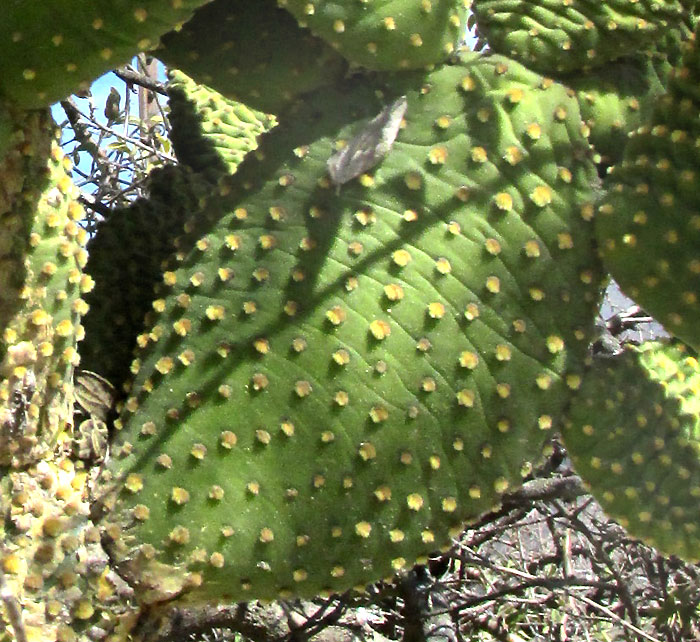Excerpts from Jim Conrad's
Naturalist Newsletter
entry from field notes dated January 20, 2023, taken in scrub along ridgetop ~1.5km south of Camargo, elevation ±1,700m (7280 ft); bedrock of fine-grained, calcareous mudrock; Querétaro state, MÉXICO, (N21.09°, W99.73°)
BUNNY-EARS PRICKLYPEAR IN HABITAT

The above pricklypear cactus grew in very thin soil atop a ridgetop limestone ledge. The big field mark for this species is that it appears to bear no spines, just bumps. Here in semiarid, upland, central Mexico, when you encounter a pricklypear, genus Opuntia, you haven't seen before, take a big breath before "doing the botany" to figure out which species you have.
At this writing a Mexican government webpage entitled Nopal, planta que documenta la historia de México, quotes Leia Scheinvar at UNAM, Mexico's main university, as saying that Mexico is home to 93 Opuntia species. Taxonomy of the genus isn't well understood. The main floras don't touch the genus, probably because the species concepts are unclear, debated and changing. Still, the spineless cactus shown above is so singular that surely it could be identified, even though flowers and fruits were missing.

The bumps on this plant's pads, or stem segments, are areoles. Areoles are the special spots where spines and tiny spine-like glochids arise. In pricklypear identification, the number of areoles per diagonal row across the middles of well developed stem segments is an important feature. Once your eye can identify a diagonal row across a big pad's middle, it's fairly easy to count the areoles. In the above picture, our plant seems to have about 16, though the rows are a bit irregular and wander a bit.

Above, up close, it's clear that the spineless areoles do produce, in abundance, the tiny spinelike items known as glochids, the hard-to-see things that stick into your fingers when you manage to avoid any regular spines. Note that the pad's surface is densely covered with short, velvety hairs. The above image also shows pads with conspicuous wrinkles.
Because this is such an unusual species, and by consulting species distribution maps, it was easy to narrow down the potential identities of our cactus to two potential species. One of them, Opuntia rufida, according to the Flora of North America, displays 8-13 areoles per diagonal row across main stem segments, or pads, while the other, Opuntia microdasys, has (9-)11-16. We counted ~16 on our plant, so OPUNTIA MICRODASYS.
The Internet abounds with pictures of Opuntia microdasys, nearly all of them growing in pots and in rock gardens. Those pictures show individuals not in the least wrinkled, for people water them. Our pictures show what the species looks like in its natural, water-restricted environment, during the dry season, after a rainy season that never developed.
Commercially, our cactus is much marketed under the names of Bunny-ears Pricklypear, Angel's-wings, and other such cloying labels hardly appropriate for such an exquisitely adapted, tough species as this. The main Spanish name for it appears to be Nopal Cegador, the term nopal being applied to all flat-padded pricklypear species, and cegador meaning "blinder." In western Texas, where the similarly looking Opuntia rufida occurs, I've heard individuals refer to the species as Horse-blinder Cactus. In fact, the 1975 work by DA Whiting and JH Bristow entitled "Dermatitis and Keratoconjunctivitis Caused by a Prickly Pear ( Opuntia microdasys)" describe irritated skin and eye problems in patients in South Africa, where Opuntia microdasys is invasive.
Opuntia microdasys is endemic just to the arid and semiarid uplands of northern and central Mexico. Here in Querétaro we're at the species' southernmost point of natural distribution. It's escaped from cultivation in Arizona, thus its inclusion in the Flora of North America. That flora tells us that our species and the similar Opuntia rufida hybridize where the two species' overlap in distribution, suggesting close kinship. In the field where both species occur they can be distinguished by the pads of our Opuntia microdasys being bright green, while the pads of Opuntia rufida are grayish green.
Not only has Opuntia microdasys escaped in Arizona, but also in many hot, dry places worldwide, as an invasive. This is indicated on the GBIF Opuntia microdasys distribution map, where the Mediterranean region, southern and eastern Africa and eastern Australia appear especially infested.
The PFAF.Org website tells us that the tuna, or fruit, of Opuntia microdasys can be eaten raw or cooked. It's relatively watery and very mucilaginous, though, and not much sought-after. The seeds can be briefly roasted, ground into powder, and used as a stew thickener.